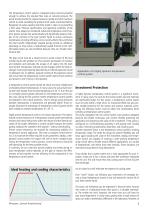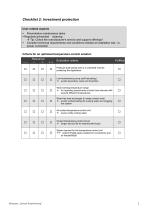
Excertos do catálogo

Economical Temperature Control Optimal temperature control of reactors Temperature Control in pharmaceutical and chemical laboratories as well as pilot plants and industrial processes requires of highly dynamic temperature control systems. When controlling reactors, endothermic and exothermic reactions must be compensated for with extreme speed and reliability. When specifying the most suitable temperature control system a variety of conditions and influences must be taken into consideration. This article provides criteria and advice for choosing the most effective and most efficient solution for your applications. Most temperature control applications involve reactors made of glass or steel. Steel reactors are more robust and durable. Glass reactors allow the chemist to view processes within the reactor. However, glass reactors require extenisve safety precautions for safe use. Reactors generally have an inner vessel containing the samples which require temperature control. The inner vessel is surrounded by a jacket which contains heat-transfer liquid. The temperature control system is connected to the reactor jacket. To control the temperature of a reactor, the temperature control system continuously pumps the heat-transfer liquid through the jacket of the reactor. Sudden changes in temperature within the reactor are dynamically balanced by rapid heat-up or cool-down. The liquid is heated or cooled within the temperature control system. A simplified temperature control system is shown on the right. Functional view of reactor temperature control Temperature control system control electronics Examples for applications of reactors • Mini plants, pilot plants (e.g. pharmaceutical, chemical industries) • Material stress tests (e.g. automotive and aircraft industries, space exploration) • Temperature simulation reactor jacket loop circuit heat transfer liquid heat exchanger Whitepaper „Optimale Temperierlosung
Abrir o catálogo na página 1
When choosing a highly dynamic temperature control system, a variety of conditions and influential factors must be taken into consideration. The aim must be to find the most effective and efficent temperature control for the intended application while assuring optimum functionality. The following chart depicts the range of possible outcomes. We will now discuss each of these factor in detail. Process stability Materials and reactor design have a significant influence on the temperature control of highly dynamic reactor systems. Of course, a glass walled vessel will transfer heat differently...
Abrir o catálogo na página 2
The temperature control system‘s integrated pump must be powerful enough to achieve the required flow rates at constant pressure. The pump should provide the required pressure quickly and with maximum control to avoid exceeding the pressure limit values mentioned before. Regulation of pump capacity should be made in steps or by presetting a limit value. Pressure specifications and operating conditions of the reactor must always be considered. Advanced temperature control systems feature pumps that automatically and dynamically balance changes of the viscosity of the heat transfer liquid to...
Abrir o catálogo na página 3
properly evaluate the size of a temperature-control system, you must look beyond just the footprint. It is absolutely essential to consider how much space will be needed for connections and adequate airflow. A space-optimized temperature control system will have as many connections and ventilation openings on the front and rear sides as possible. Units designed in this way will save you valuable space by allowing you to place additional laboratory devices directly next to the temperature-control system. Poorly designed units will require you to reserve additional space that must be kept...
Abrir o catálogo na página 4
It is common practice in laboratories to conduct a series of experiments under identical temperature conditions. Even failed experiments usually must be repeated precisely under the same control parameters. The temperature-control system should contain functions that enable precise reproducibility in these situations. These functions simultaneously lower the expense of generating documentation for an experiment. Although temperature-control systems are increasingly equipped with intuitive operating functions, it is still advisable to inquire about user training from the manufacturer of the...
Abrir o catálogo na página 5
User-related aspects ■ Calculate the required cooling/heating capacity ^ Tip: Ask the manufacturer to calculate the correct cooling/heating capacity! ■ Compare the required working temperatures with the working temperature range of the temperature-control solution ^ Tip: Ask the manufacturer for assistance! ■ Observe the pressure values and operating conditions of the reactor ■ Ensure thorough mixing in the reactor Whitepaper „Optimale Temperierlosung
Abrir o catálogo na página 6
User-related aspects ■ Preventative maintenance tasks ■ Regularly-scheduled cleaning ^ Tip: Check the manufacturer's service and support offerings! ■ Consider technical requirements and conditions needed at installation site, i.e. power connection Whitepaper „Optimale Temperierlosung
Abrir o catálogo na página 7
User-related aspects ■ Operator must observe Machinery Directive ■ User must be trained and have the necessary skills and knowledge ^ Tip: Ask the manufacturer about user training! Whitepaper „Optimale Temperierlosung
Abrir o catálogo na página 8Todos os catálogos e folhetos técnicos JULABO GmbH
-
DYNEO
34 Páginas
-
MAGIO
28 Páginas
-
RECIRCULATING COOLERS/ CHILLE
42 Páginas
-
Refrigerated and heating circulators
28 Páginas
-
CORIO Brochure English
50 Páginas
-
JULABO Product Portfolio
32 Páginas
-
PURA 10 Brochure en
12 Páginas
-
PURA 4 Brochure en
12 Páginas
-
PURA 30 Brochure en
12 Páginas
-
PURA 14 Brochure en
12 Páginas
-
Product data sheet PRESTO W56
2 Páginas
-
DYNEO Brochure
34 Páginas
-
JULABO Thermal Bath Fluids
32 Páginas
-
PURA 22 Brochure en
12 Páginas
-
CORIO Brochure English
50 Páginas
-
Product data sheet PRESTO W55
3 Páginas
-
JULABO Productportfolio
28 Páginas
-
JULABO-Recirculating-Coolers-Chillers
42 Páginas
-
JULABO-TopTech
64 Páginas
-
Booster pump
2 Páginas
-
JULABO WirelessTEMP - Solution Finder
24 Páginas
-
JULABO Booster Pump
2 Páginas
-
JULABO WirelessTEMP
24 Páginas
-
Water Baths - Shaking Water Baths
8 Páginas
Catálogos arquivados
-
DYNEO Brochure english
18 Páginas
-
DYNEO DD-BC26 Brochure en
16 Páginas
-
DYNEO DD-601F Brochure en
16 Páginas
-
DYNEO DD-1000F Brochure en
16 Páginas
-
DYNEO DD-300F Brochure en
16 Páginas
-
DYNEO DD-BC4 Brochure en
16 Páginas
-
DYNEO DD-1001F Brochure en
16 Páginas
-
DYNEO DD-900F Brochure en
16 Páginas
-
DYNEO DD-BC6 Brochure en
16 Páginas
-
DYNEO DD-600F Brochure en
16 Páginas
-
DYNEO DD-BC12 Brochure en
16 Páginas
-
FX30 Brochure en
4 Páginas
-
DYNEO Brochure english
34 Páginas
-
FX Industrial Chiller
4 Páginas
-
JULABO-DYNEO-Broschuere
20 Páginas
-
DYNEO™
20 Páginas
-
JULABO Brochure EN
178 Páginas
-
JULABO DYNEO Laboratory Circulators
16 Páginas
-
JULABO PURA Water Baths
12 Páginas
-
PRESTO W50 / W50 t flyer
2 Páginas
-
Recirculating Coolers / Chillers
6 Páginas























































